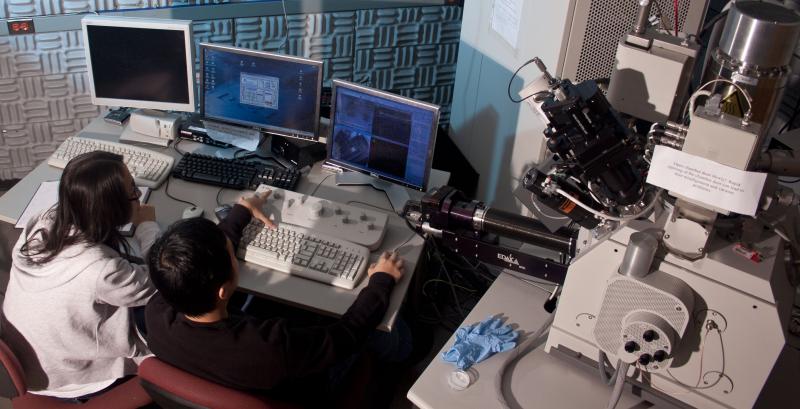Description
The Nova NanoLab is a ultra-high resolution field emission scanning electron microscopy (SEM).
Electron Optics
- High-resolution Field Emission-SEM column, with monopole magnetic immersion final lens, Schottky thermal field emitter, 60 degree objective lens geometry and heated objective apertures.
- Resolution @ optimum WD.
- 1.1 nm @ 15 kV (TLD-SE).
- 2.5 nm @ 1 kV (TLD-SE).
- 3.5 nm @ 500V TLD-SE.
- 5.5 nm @ 500 V TLD-BSE.
- Resolution @ beam coincidence point.
- 1.0 nm @ 30 kV STEM.
- 1.5 nm @ 15 kV (TLD-SE).
- 2.0 nm @ 5 kV (TLD-SE).
- Max. Horizontal field width: 3.0 mm at beam coincidence point (corresponds to 35x minimum magnification in quad view).
- Accelerating voltage: 200 V – 30 kV.
- Probe current: <= 20 nA in 21 steps.
Detectors
- ETD--Everhart-Thornley Detector for detecting secondary electrons, backscattered electrons, with additional custom capabilities.
- TLD-Through the Lens Detector for detecting secondary electrons, backscattered electrons, with additional custom capabilities.
Digital image processor
- Dwell: 50 ns - 1 ms.
- 11 presets + photo + snapshot.
- Up to 3584 x 3094 pixel resolution.
- File type: TIFF (8 or 16 bit), BMP or JPEG.
- Single frame or 4-quadrant image display.
- 4 quadrants live.
- up to 256 frame averaging or integration.
Access Policies
Policies and Procedures for Access, Development and Maintenance
The FEI Nova 200 Dual-Beam FIB has been acquired under the NSF Major Research Instrumentation Program, with additional support from Arizona State University. This instrument will be made available to the ASU and broader community as a user facility, and should facilitate a wide range of applications involving the fabrication of nanostructures. No radioactive samples, and the sample must survive in a vacuum and under the electron beam.
Contact
Ken Mossman
Research Specialist
kenneth.c.mossman@asu.edu
480.965.0946
Techniques
- Focused ion beam and sample preparation
Documents and manuals
- File
- Filescanning_electron_microscopy.pdf64.26 KB
ASU Unit
Knowledge Enterprise
Rates
| Cost for ASU Internal | Cost for ASU Internal with Staff Assistance | Cost for Other Academic/Non-Profit | Cost for Other Academic/Non-Profit with Staff Assistance |
|---|---|---|---|
|
$76.44/h
|
$119.49/h
|
$162.96/h
|
$259.56/h
|
Photos


